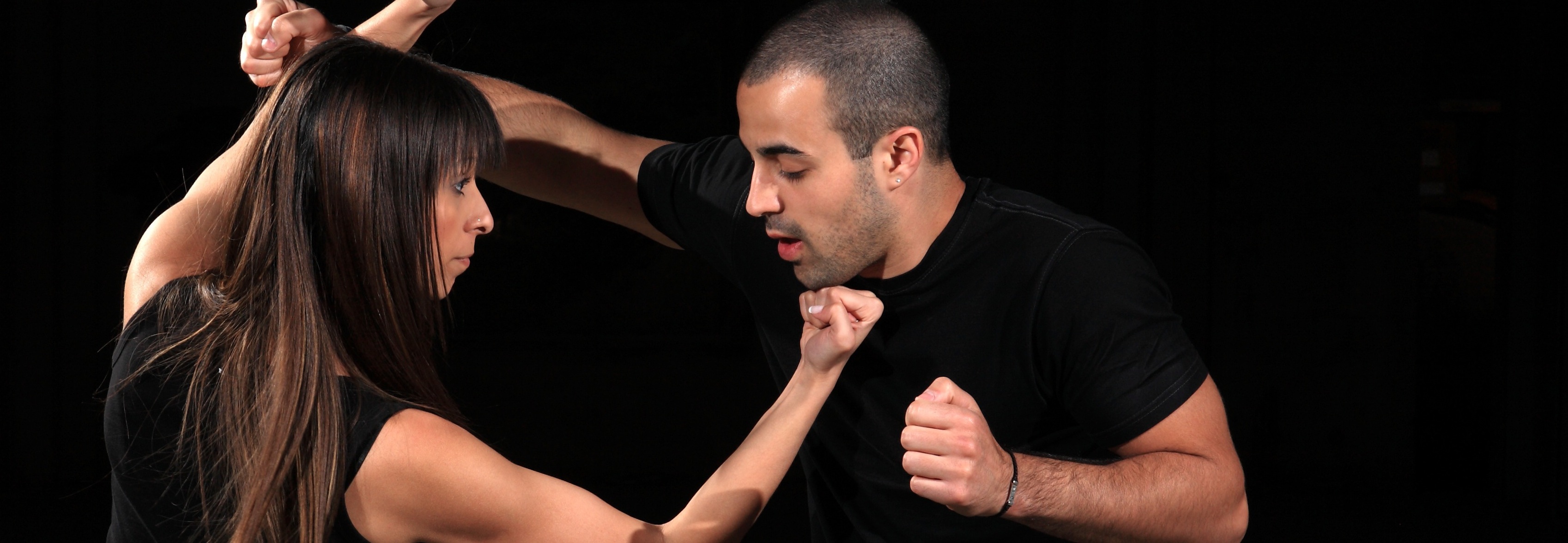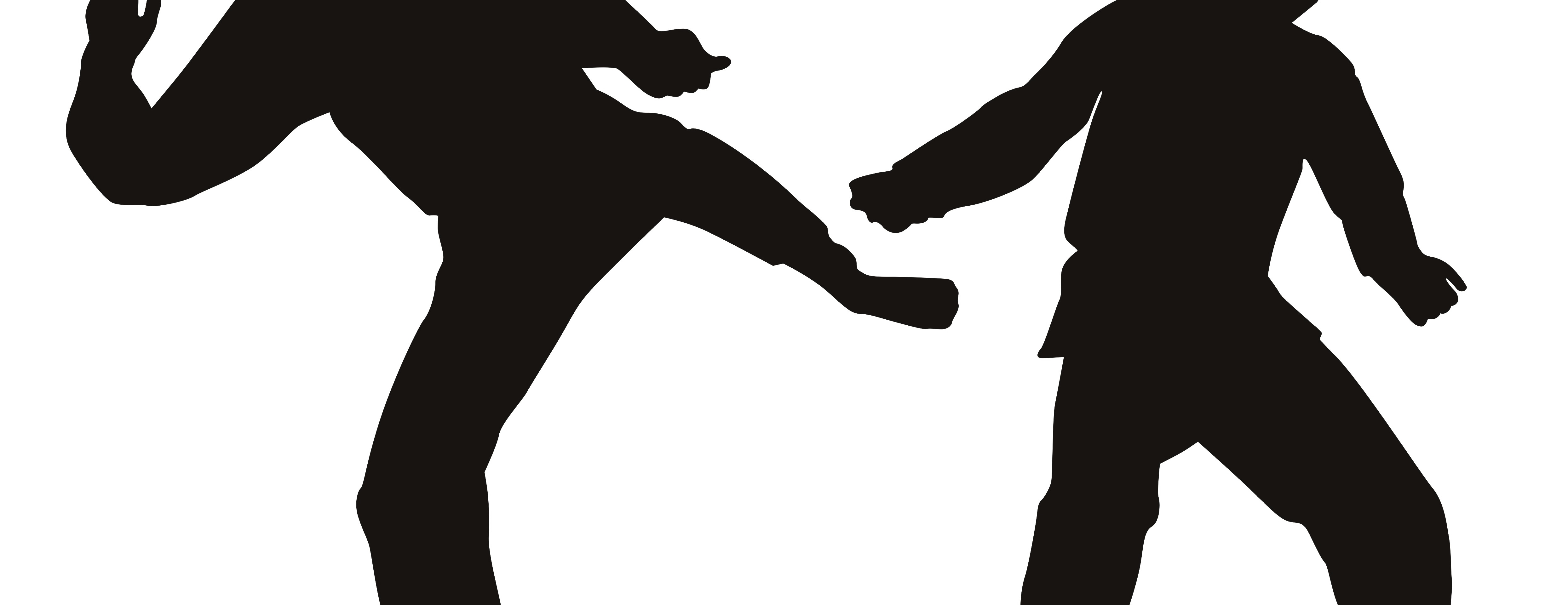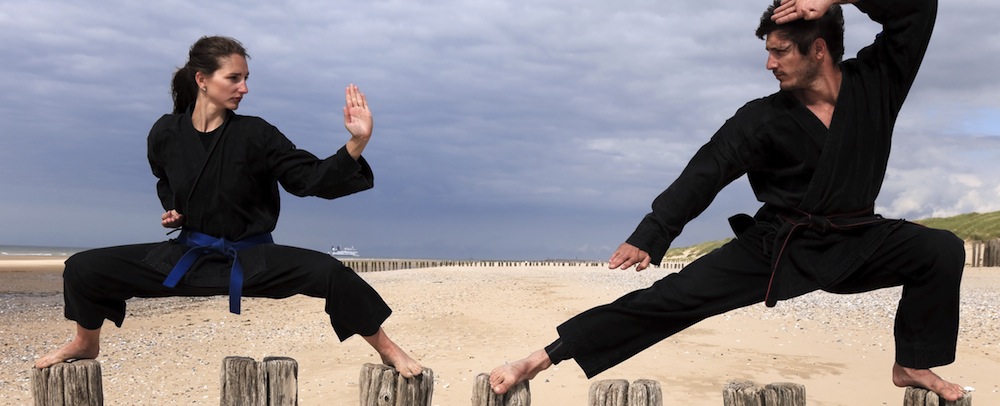Purple Belt
GERI WAZA:





Purple Belt Kicks
KATA: naihanchi shodan | gekisai dai ni | naihanchi nidan | pinan shodan* | rohai





Purple Belt Kata
BUNKAI / OYO: form interpretation*





Purple Belt Bunkai
CONDITIONING: 10 straight across | sit outs – 10 per side | 4 corners – 10 per side | bridges – 10 per side
RANDORI
KUMITE: free sparring
STUDY: awareness (below) | adrenal stress response (below)
Awareness
Eye contact and general situational awareness are important to personal protection. Awareness; getting your head up and engaging your environment may be the single most important thing you can do to protect yourself.
What is awareness? Awareness is reading your environment; people, situations, locations. It means anticipating the possibility and probability of violence before it occurs. A predator’s primary target is someone unaware of his or her surroundings and lax about personal safety.
Awareness is knowledge of what to look for and taking the time to notice safety related aspects of your surroundings. The earlier you detect and recognize a potential threat, the more options you have to resolve it.
Awareness is realizing some circumstances call for a greater degree of awareness than others. You want to pay closer attention walking to your car alone at night than when shopping with friends in the middle of the day.
Awareness is being aware of your mental maps. A mental map, or schema, is the way we perceive a given situation. Our schema may be right or wrong. Effectively defending yourself requires an accurate mental map about self-defense situations. Assessing our own mental maps can be difficult. We tend to resist anything that challenges our existing perception of the way things are.
Awareness is not paranoia. You cannot spend your life frantically scanning your surroundings for trouble.
Learning to read your physical environment is really pretty easy. Here are some things to keep in mind when you are out. Is your location remote or public? Is your location near a remote site like an alley, side street, doorway or parking ramp? How is the area lit? Are there any natural hiding places from which a predator might be able to surprise you? Is this area known for violent encounters? Where are the natural exits?
Reading people is something you do all the time. Pay attention to the people moving through your environment. Notice peoples moods. What is their body language telling you? Pay attention to you intuition. Some research suggests that intuition is a physical phenomenon that seems to involve subcncious processing of large amounts of data. When patterns are detected this knowledge is brought to the attention of the conscious mind.
Is a stranger paying too much attention to you? Does that person have one or both of their hands in their pockets? Is their posture unnatural, as if they are hiding one or both of their hands? Is a stranger or person you barely know asking for the time, directions, a light or money? Is that person uncomfortably close to you? Is an acquaintance unexpectedly making small talk in a remote, poorly lit location like a parking garage? Has an acquaintance shown up at your home or office unexpectedly?
If you find yourself answering yes to any of these questions, red flags should go up in your head. You need to leave the danger zone and move to a place of safety.
Awareness is a skill. Therefore, practice will improve your awareness capabilities. Here are a few things you can do to sharpen your awareness skills.
Analyze the news to become familiar with criminal patterns and the factors that contribute to violent crime. Apply the questions who, what when, where, why and how to each item reviewed. Be patient, sometimes you have to follow a story for several days in order to glean all this information from the newspaper, television, radio or the internet.
Practice being observant; pre-determine specific things to look for as you go about your daily activities. Make a game out of spotting tall, dark haired men with mustaches. Next time look for all blue cars or all blond men with ponytails. As a bonus, playing awareness games may make you look more observant to a predator evaluating you as a potential target.
When you walk into an occupied room, scan the room from left to right for two to three seconds. Try to assess the mood of each person.
Try the ‘Hostile Awareness Drill’. Play ‘what if’? If this person attacked me, what would I do? What natural weapons are available to me? What is my escape route?
In order to more easily discuss awareness we have adapted the Awareness Color Spectrum used by the military, police and others to define the different stages of awareness begore, during and after a violent encounter.
CONDITION WHITE
You are completely unaware of your environment. You could simply be inattentive, lost in thought, concentrating on something to the exclusion of all outside concerns or asleep.
CONDITION GREEN
A relaxed state of alertness; there is no imminent threat, but you are still looking for anything out of the ordinary. Studies show that reasonably well adjusted people can remain in this condition for months with no adverse physical or psychological effects. This is the condition you should be in whenever you are out in public.
CONDITION YELLOW
The state of alertness you enter when ‘something isn’t right’. This is the level of alertness where you begin to scan your surrounding for anything out of place and potentially dangerous. Your ‘fight or flight’ response may begin and adrenaline will be released into your system.
CONDITION ORANGE
A threat or attack is imminent but has yet to become immediate. Adrenaline is pumping through your system and you are beginning to feel the effects of adrenal stress response.
CONDITION RED
The threat has become immediate and urgent. You are under attack and must respond.
CONDITION BLACK
Conscious thought is suspended. You panic and freeze or react on instinct and training.
ADRENAL STRESS RESPONSE
The rush of adrenaline you get in the fight or flight response will make your palm sweat, your heart pound and will redirect physical resources to your large muscle groups, diminishing your fine motor skills. You may feel the need to throw up or relieve yourself.
You will experience tunnel vision where your mind focuses on the threat to the exclusion of much of your ordinary peripheral vision. It appears as if you are looking at the threat through a tunnel or tube and it requires conscious effort to see more than a few degrees to the right or left, up or down. This can be a problem when dealing with multiple opponents or in seeing the police when they arrive.
Like tunnel vision, auditory exclusion also screens out everything extraneous to immediate survival. You could also call this phenomenon ‘tunnel hearing’. Once again, this is a problem when you are facing multiple opponents but it is particularly troublesome when the police arrive and are shouting instructions you can not hear.
Some people will experience tachypsychia which literally means ‘the speed of the mind’. It is the distortion of perceived time. In a life-or-death situation the mind kicks into overdrive, perceiving far more information than normal. This causes the perception that things are happening in slow motion. Tachypsychia can also work in the other direction; we have all heard people say… “It happened so fast!”
In some rare occasions with highly trained people a phenomenon called psychological splitting will occur. When a person has trained to the point they can do something on autopilot – coupled with an event that triggers fight or flight – the body move so fast that the conscious mind can not keep up. This can result in the perception of watching oneself in the third person. Almost like watching yourself in a movie.
— Instructors may alter requirements as deemed appropriate —




















